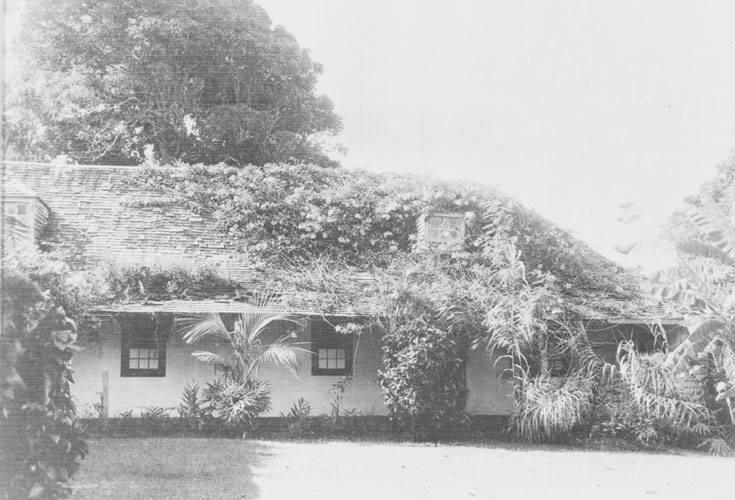At the time of the arrival of Europeans in the Hawaiian Islands during the late-eighteenth century, Waikīkī had long been a center of population and political power on Oʻahu. Starting back in the end of the fourteenth century, Waikīkī had become “the ruling seat of the chiefs of O’ahu,” including Kamehameha, who resided here after conquering Oʻahu in 1795.
In 1819, Kalanimōkū was the first Hawaiian Chief to be formally baptized a Catholic, aboard the French ship Uranie. “The captain and the clergyman asked (John) Young what Ka-lani-moku’s rank was, and upon being told that he was the chief counselor (Kuhina Nui) and a wise, kind, and careful man, they baptized him into the Catholic Church” (Kamakau). Shortly thereafter, Boki, Kalanimōkū’s brother (and Governor of Oʻahu,) was baptized.
In July 1827, three Sacred Hearts priests and three Sacred Hearts brothers from France arrived in Honolulu to begin the Hawaiian Catholic Mission. The beginnings of the Mission were difficult. They were neither welcomed by the royal government nor by the Protestants already in the Islands.
France, historically a Catholic nation, used its government representatives in Hawaiʻi to protest the mistreatment of Catholic Native Hawaiians. Captain Cyrille-Pierre Théodore Laplace, of the French Navy frigate “Artémise”, sailed into Honolulu Harbor in 1839 to convince the Hawaiian leadership to get along with the Catholics – and the French. Finally, the persecution ended in June and the kingdom granted religious freedom to all.
With Catholics now free to practice their faith, a small Catholic chapel was built in 1839 in Waikīkī “in the Hawaiian style,” likely consisting of posts and thatch on the beach near the present Kalākaua Avenue.
This chapel was re-built 15 years later (in 1854) at that beach location in Western-style wooden framing (from the lumber of shipwrecked ships.) The size of this chapel was about 20 feet by 40 feet, with a steeple.
Waikīkī continued to grow and improvements to the chapel were made later by putting in flooring, galvanized roofing, and lattice walls. This church site on the beach served its purpose for many years, until the site was exchanged for a piece of land on what is now ʻOhua Avenue.
The chapel was used primarily for devotions; parishioners still had to go to the Cathedral of Our Lady of Peace (in downtown Honolulu) for Sunday Mass.
During the Spanish-American War, American soldiers were garrisoned at Kapiʻolani Park (at a temporary Camp McKinley – 1898-1907) and the Catholic soldiers wanted a regular Catholic Mass in Waikīkī, so permission was given for Mass every Sunday. A larger chapel was built to accommodate all the worshippers.
The soldiers left when the war ended, but by that time there was a growing Catholic community in Waikīkī. On August 28, 1901, a more permanent church with lattice-work walls reminiscent of the palm fronds of the first chapel in Waikīkī.
As Waikīkī grew, so did the church; it was expanded twice, in 1910 and then in 1925; but time, a growing population and termites took their toll and by the early-1960s a larger church was needed.
In 1962, the present church was blessed. Designed by local architect George McLaughlin, the design reflects hands folded in prayer. The 20-side stained glass windows depict 15-mysteries of the rosary, the arrival of the missionaries, the first lay catechists (Catholic teachers of the faith) in Hawaiʻi, Father Damien and the bishop receiving the current church.
Today, St Augustine-by-the-Sea Church sits within urban Honolulu at the eastern end of the Waikīkī resort area. It is surrounded by modem urban development and high-rise hotels.
St. Augustine by-the-sea has not undergone any major exterior renovations or improvements since its construction in 1962. The church recently published a Master Plan and Environmental Assessment for a new multi-purpose Parrish Hall, as well as other improvements.
St. Augustine features a small museum dedicated to the life and times of St. Damien of Molokaʻi. In 1863, his brother, who was to leave for the Hawaiian Islands, became ill and Damien took his place. He arrived in Honolulu on March 19, 1864, and was ordained at the Cathedral of Our Lady of Peace (in downtown Honolulu) on May 21, 1864.
For the next nine years he worked in missions on the big island, Hawaiʻi. In 1873, he went to the leper colony on Molokaʻi, after volunteering for the assignment. He announced he was a leper in 1885 and continued to build hospitals, clinics and churches, and some six hundred coffins. He died on April 15 1885, on Molokaʻi. (Lots of information and images from St. Augustine website and related reports.)

















































